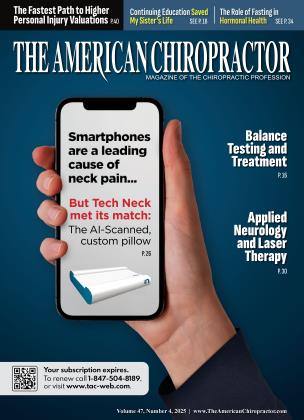
A 2024 STUDY HIGHLIGHTS THE FACT THAT 30% of the population is affected by at least one form of sleep disturbance,1 and the Centers for Disease Control has reported that 20 to 25 % of Americans have chronic pain. That means nearly a third of your patients suffer from one, if not both, of those maladies. Research also shows that an inflammatory cascade begins when an adult gets less than seven hours of sleep, feeding the chronic pain cycle and opening the door for increased pain and autoimmune disease activation.2
As practitioners, we need to understand that quality and quantity of sleep ergonomics are critical to address with each patient throughout the treatment phase of care and post-care beyond the adjusting table. Foot Levelers pioneered the world’s first cervical support pillow in 1964 and has been improving upon its groundbreaking design ever since. The new custom pillow, NEXI (Neck Ergonomics with Intelligence), paired with its custom orthotics, can significantly help practitioners in their care plans. Still, one must first understand the effects of pain and lack of sleep and how they are intertwined.
Chronic pain and sleep disturbances form a complex, bidirectional relationship that significantly affects patient outcomes and quality of life. Sleep disturbances hinder the body’s natural recovery, delaying tissue repair and immune function. Prolonged disruptions in sleep can extend rehabilitation timelines and reduce the efficacy of pain management strategies.3
Additionally, patients with sleep disorders are at an increased risk for developing immune-mediated diseases, such as irritable bowel syndrome, rheumatoid arthritis, fibromyalgia, multiple sclerosis, psoriasis, and lupus.4 Patients with immune-mediated illness are more likely to suffer from a relapse or early onset of symptoms when a sleep disturbance is present.4
Anxiety and depression are also prevalent in this population, further compounding the challenges of effective pain management. That is why addressing sleep dysfunction through multimodal strategies that promote proper spinal alignment can be pivotal in breaking the chronic pain cycle. For clinicians, understanding this interplay and integrating evidence-based approaches is essential for effective pain management in clinical practice.
Chronic pain and sleep disturbances share several interconnected mechanisms. Sleep deprivation heightens central sensitization, a condition in which the nervous system becomes overly reactive to nociceptive inputs. This increased sensitivity exacerbates the perception of pain.
Additionally, disrupted sleep promotes the release of pro-inflammatory cytokines, such as IL-6 and TNF-a, which further amplify pain perception (Haack et al., 2019). Dysregulation of the hypothalamic-pituitary-adrenal (HPA) axis also plays a significant role, with elevated cortisol levels disrupting sleep patterns and exacerbating pain cycles.2
Improper spinal alignment during sleep can compound these issues. When the spine is not neutral, it places undue mechanical stress on the musculoskeletal system, leading to nocturnal discomfort and morning stiffness. Over time, this contributes to fragmented sleep and increased pain sensitivity, creating a self-perpetuating cycle of discomfort and sleep disturbance.
“Sleep deprivation heightens central sensitization, a condition in which the nervous system becomes overly reactive to nociceptive inputs.”
Foot Levelers has developed a revolutionary advancement in sleep technology: the world’s first fully customized pillow — NEXI. This pioneering development emerges from the latest sleep science examining the factors that prevent us from having the restorative, restful sleep we all require. NEXI is a breakthrough that addresses some of the primary culprits discussed earlier: chronic pain, inflammatory responses, and serial distortions. It is designed to meet the needs of all patients with its dual restorative and recovery design, making it the all-in-one sleeping solution.
The pillow’s restorative side is for patients who are not injured and will benefit from a design that contours to the natural curvature of each patient’s cervical spine, promoting even weight distribution and reducing pressure points. Maintaining this neutral neck position minimizes strain and prevents exacerbation of pain during sleep.
NEXI can also be flipped over to the recovery side, which is flat to help accommodate the pain scales for extreme problems like whiplash while also addressing more common issues such as tech neck, tension headaches, and other conditions associated with poor posture.
In a randomized controlled trial, Lee et al. (2021) demonstrated that ergonomic pillows significantly reduced neck pain and improved sleep efficiency in patients with chronic pain.5 An optimal sleep position has also been shown to help interrupt nociceptor input, thus decreasing pain. These findings underscore the importance of tailored interventions in addressing the interplay between spinal alignment, sleep, and pain. Based on this study, a custom pillow optimally designed to support a patient’s ideal sleep posture is critical.
NEXI can revolutionize the sleep industry in your clinic. It is the only genuinely custom pillow available on the market. Like a fingerprint, no two NEXI pillows are identical. Each pillow is crafted based on the patient’s unique measurements captured with the Posture Check 3D, using AI technology to build the pillow when ordered. NEXI helps support proper cervical aligmnent, reduces pain, and enhances sleep quality. It allows healthcare providers to provide head-to-toe care to thenpatients through intuitive and noninvasive care plans that include custom orthotics and the latest sleep innovation from Foot Levelers.
Scanning the head and neck with the Posture Check 3D is the first step to building a patient’s NEXI. It takes over 130,000 precise 3D data points of the patient’s neck and shoulder dimensions, including the severity of a patient’s forward head posture. Each patient’s age, weight, sleeping position, and natural respiratory issues, like snoring, are also factored into the customization of their NEXI.
The level of personalization is a breakthrough in the quest for optimal sleep posture. Based on the previously mentioned specifications, a pillow with the appropriate style, loft, and incline can be prescribed for the patient’s optimal sleep position.
Proper sleep positioning and aligmnent education are essential for maximizing NEXTs therapeutic and healing benefits. Initial users of the pillow shared that they experienced reduced nocturnal pain and stiffness, enhanced sleep quality (including deeper sleep), and improved long-term pain management.
By understanding the relationship between chronic pain and sleep disturbance and the general public’s need for proper sleep posture, practitioners can better investigate the true causes of the patient’s failure to recover from injury. Scanning every patient with the Foot Levelers Posture Check 3D is a clinically proven method to customize a patient’s care plan for optimal health outcomes.
The pronation stability index and forward head posture scans analyze over 400,000 data points for a custom report of findings unmatched by any other technology. More than 130,000 of those data points are used to build the NEXI pillow, which is designed to aid in the patient’s recovery sleep cycle and is an optimal way to treat patients who suffer from various health problems associated with serial distortion and sleep disturbances.
Using NEXI and custom orthotics from Foot Levelers offers the world’s first dual solution to help patients maintain their spine’s natural curve and solve the problems of serial distortion. Custom orthotics and the NEXI pillow can also help mitigate nociceptor input for pain and proprioceptor and mechanoreceptor input for position, pressure, and imbalance. By incorporating these strategies into clinical practice, healthcare providers will help ensure patient compliance, improve patient outcomes, enhance quality of life, and foster long-term recovery.

Dr. Christine Foss is the Director of Education and Research for Foot Levelers. For more information, go to footlevelers.com/more.
1. Sochal M, Ditmer M, Turkiewicz S, Kamga FF, Bialasiewicz P, Gabryelska A. The effect of sleep and its restriction on selected inflammatory parameters. Sci Rep. 2024 Jul 29; 14(1): 17379. doi: 10.1038/s41598-024-68498-l. PMID: 39075123; PMCID: PMC11286918.
2. Afolalu EF, et al. Bidirectional relationship between sleep disturbances and chronic pain: A systematic review. Sleep Medicine Reviews. 2018;39:103-116.
3. Krietsch KN, et al. The role of sleep in pain and recovery: beyond the brain. Pain Management. 2019;9(3):259-268.
4. Ditmer M, Gabryelska A, Turkiewicz S, Bialasiewicz P, Malecka-Wojciesko E, Sochal M. Sleep problems in chronic inflammatory diseases: prevalence, treatment, and new perspectives: a narrative review. J Clin Med. 2021 Dec 23;11(1):67. doi: 10.3390/jcmll010067. PMID: 35011807; PMCID: PMC8745687.
5. Lei JX, Yang PF, Yang AL, Gong YF, Shang P, Yuan XC. Ergonomic consideration in pillow height determinants and evaluation. Healthcare (Basel). 2021 Oct 7;9(10):1333. doi: 10.3390/healthcare9101333. PMID: 34683013; PMCID: PMC8544534.
 View Full Issue
View Full Issue






